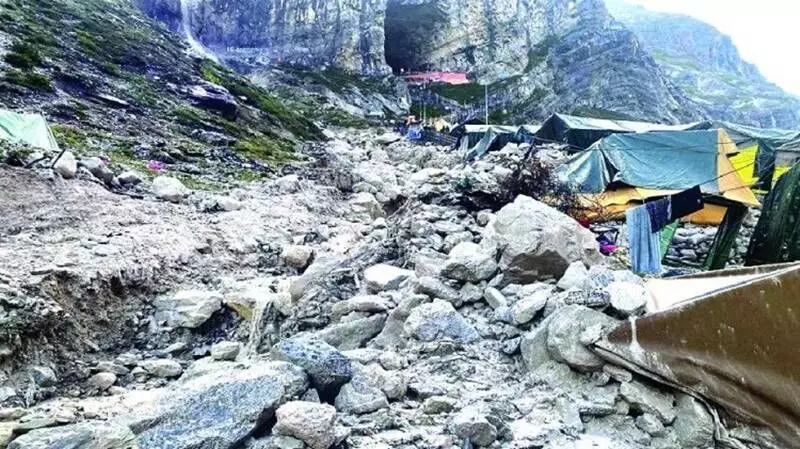'Amarnath cloudburst like incidents likely to increase due to climate change'
According to the notes prepared by a climate change awareness group, with the increasing global temperatures, winds can hold more moisture and this increased moisture can lead to increased amount of 'short duration intense rainfall' as in case of a cloudburst.
 गाँव कनेक्शन 11 July 2022 2:22 PM GMT
गाँव कनेक्शन 11 July 2022 2:22 PM GMT

As per the briefing, weather conditions remain conducive for Kashmir region to witness some more incessant showers.
In the wake of the cloudburst at Jammu and Kashmir's Amarnath shrine which killed at least 16 devotees on July 8, a climate communications firm has stated that the frequency of such inadvertent events is likely to increase with the rise in global temperatures.
"Scientific evidences have already confirmed that extreme rainfall is going to get intense and frequent. Cloudburst could be more as well as intense due to global warming," mentions a press briefing prepared by Climate Trends — a Delhi-based strategic communications group which works to raise awareness around the issue of climate change.
Cloud burst can be defined when a localised area receives very heavy rainfall to the tune of 100mm or more within an hour along with squally winds and lightning. Meanwhile, a rainfall event is defined as mini cloud burst if a certain area records more than 50 mm in two consecutive hours. These occurrences are predominant over the mountainous regions of northern part of India, especially during the monsoon season.
"As per a research, analyses from the observations show a decline in number of thunderstorm days (1981–2010 relative to 1950–1980) by 34% over the Indian region, while there is a rise in short-span high-intensity rain occurrences (short-lived cloudburst and mini-cloudbursts) along the west coast of India (5 per decade) and along the foothills of western Himalayas (1per decade) during the 1969– 2015 period (high confidence)," it added.
As per the briefing, weather conditions remain conducive for Kashmir region to witness some more incessant showers.
"With the western end of the Monsoon trough now shifting northwards towards the foothills of Himalayas, there are chances of heavy to very heavy rainfall across Uttarakhand. Incidences of cloudburst, flash flooding and landslide cannot be ruled out," it stated.
The briefing explained that frequency of cloudburst events in the western Himalayan region has been on the continuous rise due to faster evaporation rates from glacial lakes at high altitudes, as a consequence of global warming.
"Besides, with the increasing global temperatures, winds can hold more moisture. Hence, this increased moisture can lead to increased amount of short duration intense rainfall. Scientific evidences have already confirmed that extreme rainfall is going to get intense and frequent. Cloudburst could be more as well as intense due to global warming," it added.
#Climate change cloudburst
More Stories




